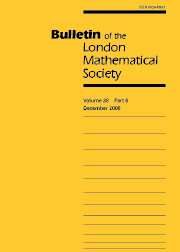Article contents
ON THE DERIVED LENGTH OF FINITE DINILPOTENT GROUPS
Published online by Cambridge University Press: 01 May 1998
Abstract
A dinilpotent group is a group that can be written as the product of two nilpotent subgroups. There is an extensive literature dealing with such groups (see, for example, the recent book of Amberg, Franciosi and de Giovanni [1]). In 1955, Itô proved in [6] that the product of two abelian groups is always metabelian, and in the following year, Hall and Higman proved, as a special case of [3, Theorem 1.2.4], that if G=AB is a finite soluble group with A and B nilpotent of coprime orders and classes c and d respectively, then G has derived length at most c+d. Wielandt [9] showed that if the finite group G=AB has A and B nilpotent and of coprime orders, then G is necessarily soluble. Kegel [7] then showed that the condition that the orders be coprime was unnecessary. A natural next question to ask is if the derived length of a finite dinilpotent group is bounded by some function of the classes of the factors, and, in the light of the Hall–Higman result and the result of Itô, the following conjecture seems natural. (The first explicit reference to this conjecture that we know of is in Kegel [8]; see also, for example, Problem 5 on page 36 of [1].)
- Type
- Notes and Papers
- Information
- Copyright
- © The London Mathematical Society 1998
- 9
- Cited by




